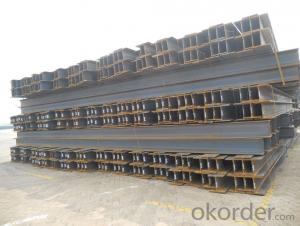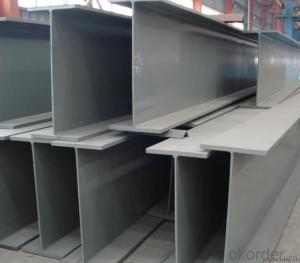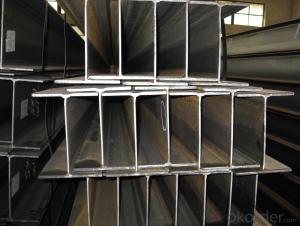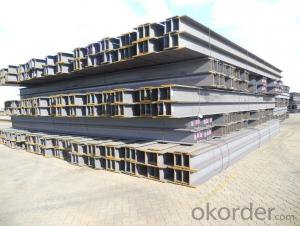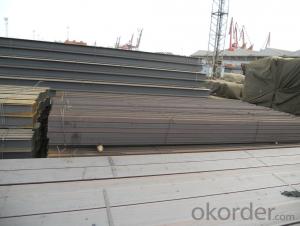High Quality Hot Rolled Jis Steel H Beam
- Loading Port:
- Tianjin
- Payment Terms:
- TT OR LC
- Min Order Qty:
- 25 m.t.
- Supply Capability:
- 1000 m.t./month
OKorder Service Pledge
OKorder Financial Service
You Might Also Like
roduct Description:
Specifications of Hot Rolled Steel H-beam
1. Standard: GB
2. Grade: Q235 or Equivalent
3. Length: 6m,10m, 12m as following table
4. Invoicing on theoretical weight or actual weight as customer request
5.Payment: TT or L/C
6. Sizes:
Category | model (height*width)/ (mm×mm) | Section size/mm | Cross-section area/cm2 | Theoretical Weight/(kg/m) | Moment of inertia/cm4 | radius/cm | Section modulus/cm3 | |||||||
H | B | t1 | t2 | r | Ix | Iy | ix | iy | Wx | Wy | ||||
HW | 100×100 | 100 | 100 | 6 | 8 | 8 | 21.59 | 16.9 | 386 | 134 | 4.23 | 2.49 | 77.1 | 26.7 |
125×125 | 125 | 125 | 6.5 | 9 | 8 | 30.00 | 23.6 | 843 | 293 | 5.30 | 3.13 | 135 | 46.9 | |
150×150 | 150 | 150 | 7 | 10 | 8 | 39.65 | 31.1 | 1620 | 563 | 6.39 | 3.77 | 216 | 75.1 | |
175×175 | 175 | 175 | 7.5 | 11 | 13 | 51.43 | 40.4 | 2918 | 983 | 7.53 | 4.37 | 334 | 112 | |
200×200 | 200 | 200 | 8 | 12 | 13 | 63.53 | 49.9 | 4717 | 1601 | 8.62 | 5.02 | 472 | 160 | |
200 | 204 | 12 | 12 | 13 | 71.53 | 56.2 | 4984 | 1701 | 8.35 | 4.88 | 498 | 167 | ||
250×250 | 244 | 252 | 11 | 11 | 13 | 81.31 | 63.8 | 8573 | 2937 | 10.27 | 6.01 | 703 | 233 | |
250 | 250 | 9 | 14 | 13 | 91.43 | 71.8 | 10689 | 3648 | 10.81 | 6.32 | 855 | 292 | ||
250 | 255 | 14 | 14 | 13 | 103.93 | 81.6 | 11340 | 3875 | 10.45 | 6.11 | 907 | 304 | ||
HM | 150×100 | 148 | 100 | 6 | 9 | 8 | 26.35 | 20.7 | 995.3 | 150.3 | 6.15 | 2.39 | 134.5 | 30.1 |
200×150 | 194 | 150 | 6 | 9 | 8 | 38.11 | 29.9 | 2586 | 506.6 | 8.24 | 3.65 | 266.6 | 67.6 | |
250×175 | 244 | 175 | 7 | 11 | 13 | 55.49 | 43.6 | 5908 | 983.5 | 10.32 | 4.21 | 484.3 | 112.4 | |
HN | 100×50 | 100 | 50 | 5 | 7 | 8 | 11.85 | 9.3 | 191.0 | 14.7 | 4.02 | 1.11 | 38.2 | 5.9 |
125×60 | 125 | 60 | 6 | 8 | 8 | 16.69 | 13.1 | 407.7 | 29.1 | 4.94 | 1.32 | 65.2 | 9.7 | |
150×75 | 150 | 75 | 5 | 7 | 8 | 17.85 | 14.0 | 645.7 | 49.4 | 6.01 | 1.66 | 86.1 | 13.2 | |
175×90 | 175 | 90 | 5 | 8 | 8 | 22.90 | 18.0 | 1174 | 97.4 | 7.16 | 2.06 | 134.2 | 21.6 | |
200×100 | 198 | 99 | 4.5 | 7 | 8 | 22.69 | 17.8 | 1484 | 113.4 | 8.09 | 2.24 | 149.9 | 22.9 | |
200 | 100 | 5.5 | 8 | 8 | 26.67 | 20.9 | 1753 | 133.7 | 8.11 | 2.24 | 175.3 | 26.7 | ||
250×125 | 248 | 124 | 5 | 8 | 8 | 31.99 | 25.1 | 3346 | 254.5 | 10.23 | 2.82 | 269.8 | 41.1 | |
250 | 125 | 6 | 9 | 8 | 36.97 | 29.0 | 3868 | 293.5 | 10.23 | 2.82 | 309.4 | 47.0 | ||
300×150 | 298 | 149 | 5.5 | 8 | 13 | 40.80 | 32.0 | 5911 | 441.7 | 12.04 | 3.29 | 396.7 | 59.3 | |
300 | 150 | 6.5 | 9 | 13 | 46.78 | 36.7 | 6829 | 507.2 | 12.08 | 3.29 | 455.3 | 67.6 | ||
350×175 | 346 | 174 | 6 | 9 | 13 | 52.45 | 41.2 | 10456 | 791.1 | 14.12 | 3.88 | 604.4 | 90.9 | |
350 | 175 | 7 | 11 | 13 | 62.91 | 49.4 | 12980 | 983.8 | 14.36 | 3.95 | 741.7 | 112.4 | ||
400×150 | 400 | 150 | 8 | 13 | 13 | 70.37 | 55.2 | 17906 | 733.2 | 15.95 | 3.23 | 895.3 | 97.8 | |
HT | 100×50 | 95 | 48 | 3.2 | 4.5 | 8 | 7.62 | 6.0 | 109.7 | 8.4 | 3.79 | 1.05 | 23.1 | 3.5 |
97 | 49 | 4 | 5.5 | 8 | 9.38 | 7.4 | 141.8 | 10.9 | 3.89 | 1.08 | 29.2 | 4.4 | ||
100×100 | 96 | 99 | 4.5 | 6 | 8 | 16.21 | 12.7 | 272.7 | 97.1 | 4.10 | 2.45 | 56.8 | 19.6 | |
125×60 | 118 | 58 | 3.2 | 4.5 | 8 | 9.26 | 7.3 | 202.4 | 14.7 | 4.68 | 1.26 | 34.3 | 5.1 | |
120 | 59 | 4 | 5.5 | 8 | 11.40 | 8.9 | 259.7 | 18.9 | 4.77 | 1.29 | 43.3 | 6.4 | ||
125×125 | 119 | 123 | 4.5 | 6 | 8 | 20.12 | 15.8 | 523.6 | 186.2 | 5.10 | 3.04 | 88.0 | 30.3 | |
150×75 | 145 | 73 | 3.2 | 4.5 | 8 | 11.47 | 9.0 | 383.2 | 29.3 | 5.78 | 1.60 | 52.9 | 8.0 | |
147 | 74 | 4 | 5.5 | 8 | 14.13 | 11.1 | 488.0 | 37.3 | 5.88 | 1.62 | 66.4 | 10.1 | ||
150×100 | 139 | 97 | 4.5 | 4.5 | 8 | 13.44 | 10.5 | 447.3 | 68.5 | 5.77 | 2.26 | 64.4 | 14.1 | |
142 | 99 | 4.5 | 6 | 8 | 18.28 | 14.3 | 632.7 | 97.2 | 5.88 | 2.31 | 89.1 | 19.6 | ||
150×150 | 144 | 148 | 5 | 7 | 8 | 27.77 | 21.8 | 1070 | 378.4 | 6.21 | 3.69 | 148.6 | 51.1 | |
147 | 149 | 6 | 8.5 | 8 | 33.68 | 26.4 | 1338 | 468.9 | 6.30 | 3.73 | 182.1 | 62.9 | ||
175×90 | 168 | 88 | 3.2 | 4.5 | 8 | 13.56 | 10.6 | 619.6 | 51.2 | 6.76 | 1.94 | 73.8 | 11.6 | |
171 | 89 | 4 | 6 | 8 | 17.59 | 13.8 | 852.1 | 70.6 | 6.96 | 2.00 | 99.7 | 15.9 | ||
175×175 | 167 | 173 | 5 | 7 | 13 | 33.32 | 26.2 | 1731 | 604.5 | 7.21 | 4.26 | 207.2 | 69.9 | |
172 | 175 | 6.5 | 9.5 | 13 | 44.65 | 35.0 | 2466 | 849.2 | 7.43 | 4.36 | 286.8 | 97.1 | ||
200×100 | 193 | 98 | 3.2 | 4.5 | 8 | 15.26 | 12.0 | 921.0 | 70.7 | 7.77 | 2.15 | 95.4 | 14.4 | |
196 | 99 | 4 | 6 | 8 | 19.79 | 15.5 | 1260 | 97.2 | 7.98 | 2.22 | 128.6 | 19.6 | ||
200×150 | 188 | 149 | 4.5 | 6 | 8 | 26.35 | 20.7 | 1669 | 331.0 | 7.96 | 3.54 | 177.6 | 44.4 | |
Usage & Applications of Hot Rolled Steel H-beam
Commercial building structure ;Pre-engineered buildings; Machinery support structure; Prefabricated structure; Medium scale bridges; Ship-building structure. etc.
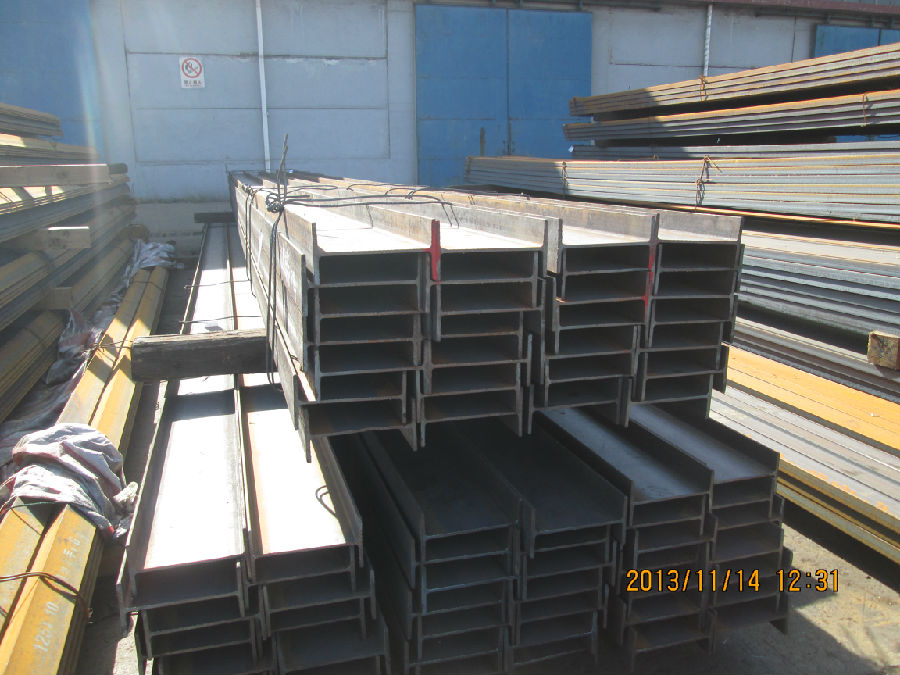
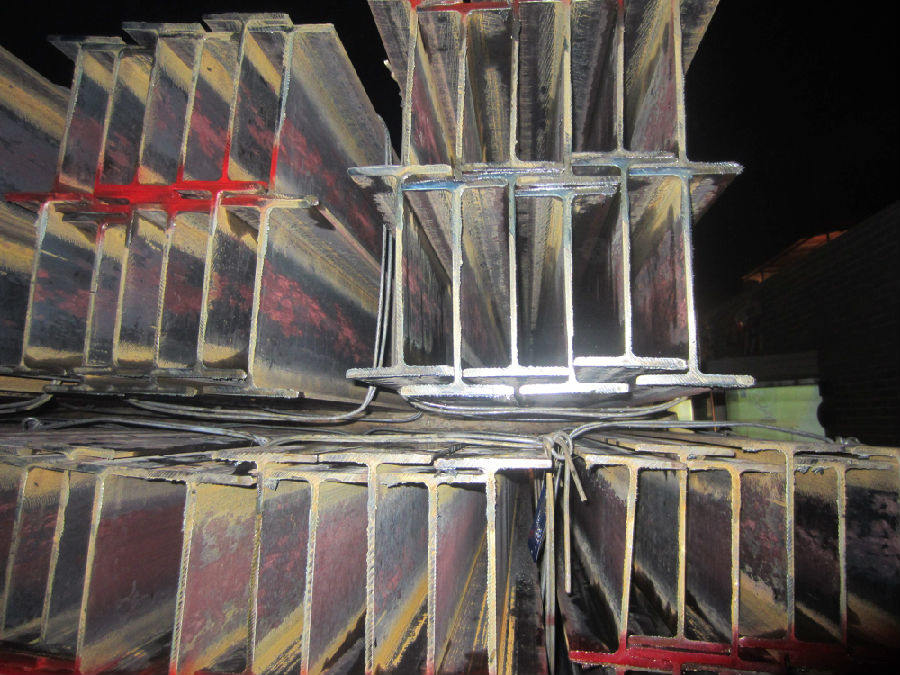
Packaging & Delivery of Hot Rolled Steel H-beam
1. Packing: it is nude packed in bundles by steel wire rod
2. Bundle weight: not more than 3.5MT for bulk vessel; less than 3 MT for container load
3. Marks:
Color marking: There will be color marking on both end of the bundle for the cargo delivered by bulk vessel. That makes it easily to distinguish at the destination port.
Tag mark: there will be tag mark tied up on the bundles. The information usually including supplier logo and name, product name, made in China, shipping marks and other information request by the customer.
If loading by container the marking is not needed, but we will prepare it as customer request.
4. Transportation: the goods are delivered by truck from mill to loading port, the maximum quantity can be loaded is around 40MTs by each truck. If the order quantity cannot reach the full truck loaded, the transportation cost per ton will be little higher than full load.
5. Delivered by container or bulk vessel
Production flow of Hot Rolled Steel H-beam
Material prepare (billet) —heat up—rough rolling—precision rolling—cooling—packing—storage and transportation
- Q:How do steel H-beams distribute loads?
- The distribution of loads in steel H-beams is achieved through a combination of their shape and material properties. The letter "H" shape of these beams offers a favorable strength-to-weight ratio, making them efficient in carrying loads. The flanges, located at the top and bottom horizontal sections of the beam, are specifically designed to resist bending and shear forces. By distributing the load over a larger area, stress concentrations are reduced, preventing deformation or failure. The vertical web, positioned between the flanges, provides additional structural support and stability. It effectively resists compression and tension forces, ensuring that the beam does not buckle or collapse when subjected to heavy loads. Moreover, the web aids in evenly distributing the load along the entire length of the beam. The material properties of steel also play a crucial role in load distribution. Steel possesses notable strength and stiffness, allowing H-beams to withstand heavy loads without experiencing significant deflection. The properties of steel, such as its Young's modulus and yield strength, contribute to the beam's effective load distribution capabilities. In summary, steel H-beams distribute loads by utilizing their structural stability provided by their shape and the load-bearing capabilities of their material properties. This makes them a popular choice for a wide range of construction and engineering applications.
- Q:What are the maximum deflection limits for steel H-beams?
- The maximum deflection limits for steel H-beams vary depending on the specific design standards and load conditions. In general, deflection limits are set to ensure the structural integrity and functionality of the beam. Common deflection limits for steel H-beams are typically in the range of L/360 to L/240, where L represents the span length of the beam. However, it is important to consult the applicable design codes and specifications to determine the exact maximum deflection limits for a specific steel H-beam application.
- Q:What are the typical uses of steel H-beams in construction projects?
- Steel H-beams are commonly used in construction projects for a variety of purposes. They are primarily used as structural support members in buildings and bridges, providing strength and stability. H-beams are often used to create the framework for large structures, such as high-rise buildings and industrial facilities. They are also utilized in the construction of bridges, where their load-bearing capacity is crucial. Additionally, H-beams can be used as columns or beams to support heavy loads and provide structural integrity. Overall, the typical uses of steel H-beams in construction projects include providing structural support, creating frameworks, and ensuring the stability and strength of various structures.
- Q:Are steel H-beams suitable for supporting mezzanine storage systems?
- Indeed, steel H-beams are a fitting choice for supporting mezzanine storage systems. Given their robustness and durability, steel H-beams are widely utilized in construction and industrial settings. They offer outstanding support for heavy loads and are engineered to endure considerable weight and pressure. Mezzanine storage systems, which necessitate sturdy and dependable support structures, demand the utmost safety and stability. Steel H-beams fulfill these prerequisites and are adept at effectively supporting mezzanine storage systems.
- Q:Are there any limitations on the span length of steel H-beams?
- Yes, there are limitations on the span length of steel H-beams. The span length refers to the distance between the supports or columns that the H-beam is placed on. The maximum span length for steel H-beams depends on various factors such as the type and grade of steel used, the design load or weight that the beam needs to support, and the allowable deflection or bending of the beam. In general, the span length of steel H-beams can vary greatly. Smaller H-beams with lower load requirements can have longer spans, while larger H-beams with higher load requirements may have shorter spans. Additionally, the span length may also be limited by local building codes and regulations. Structural engineers and architects typically calculate the maximum span length of steel H-beams using engineering principles and design software. They consider factors such as the beam's moment of inertia, section modulus, and load distribution to determine the appropriate span length for a given application. It is important to consult with a qualified structural engineer or design professional when determining the span length of steel H-beams for a specific project. They will be able to analyze the specific requirements and conditions to provide accurate and safe recommendations for the maximum span length of the H-beams.
- Q:Can steel H-beams be used in sports stadiums and arenas?
- Yes, steel H-beams can definitely be used in sports stadiums and arenas. Steel H-beams are known for their strength and durability, making them an ideal choice for large structures like stadiums and arenas. They provide excellent load-bearing capabilities, allowing for the construction of grandstands, roofs, and other structural elements that are crucial in these types of venues. Additionally, steel H-beams can be designed and fabricated to different sizes and specifications, making them adaptable to the specific requirements of each sports stadium or arena project. Their versatility, strength, and cost-effectiveness make steel H-beams a popular choice in the construction of sports facilities worldwide.
- Q:Can steel H-beams be used in gymnasium structures?
- Yes, steel H-beams can be used in gymnasium structures. Steel H-beams are commonly used in construction due to their high strength and durability. They provide excellent support and stability, making them suitable for large open spaces like gymnasiums. Additionally, steel H-beams can be easily fabricated and customized to fit the specific design requirements of a gymnasium. They can withstand heavy loads and provide the necessary structural integrity needed for gymnasium structures.
- Q:Can steel H-beams be used in railway infrastructure?
- Yes, steel H-beams can be used in railway infrastructure. They are commonly used for various applications such as constructing railway bridges, supporting railway tracks, and creating structural elements in railway stations and terminals. Steel H-beams offer significant strength and durability, making them suitable for withstanding heavy loads and providing stability in railway infrastructure.
- Q:What are the different sizes of steel H-beams available?
- To cater to diverse construction and engineering requirements, a range of steel H-beams, also known as wide flange beams, is offered in various sizes. The dimensions of these H-beams, including height, width, and weight per foot, typically determine their sizes. Take a look at the following commonly used steel H-beam sizes: 1. Standard H-beams: These H-beams, which adhere to the standards set by the American Society for Testing and Materials (ASTM), are widely utilized. They come in different sizes, with heights ranging from 3 inches to 24 inches and widths ranging from 3 inches to 12 inches. The weight per foot of standard H-beams varies depending on the specific size and steel grade employed. 2. Wide flange beams: Also referred to as W-beams, wide flange beams possess wider flanges in comparison to standard H-beams. These flanges are designed to distribute loads over a larger area, making them suitable for applications demanding higher load-bearing capacity. Wide flange beams are available in heights ranging from 4 inches to 44 inches and widths ranging from 4 inches to 16 inches. 3. European standard beams: Apart from the American standard sizes, European standard beams are designated based on their height in millimeters. These beams are commonly used in Europe and encompass heights ranging from 80 mm to 750 mm. 4. Specialized H-beams: In addition to standard and European sizes, specialized H-beams are also available for specific applications. Heavy-duty H-beams find application in industries and structural projects, while lightweight H-beams are commonly used in residential construction and smaller-scale endeavors. It is crucial to note that the availability of different sizes may vary depending on the supplier or manufacturer. When selecting steel H-beams for a project, it is advisable to seek guidance from a structural engineer or supplier who can recommend the appropriate size and grade of H-beams for the specific application.
- Q:How do steel H-beams contribute to the overall stability of a building?
- Steel H-beams contribute to the overall stability of a building in several ways. Firstly, H-beams are designed to support heavy loads and resist bending, making them suitable for structural applications. The shape of the H-beam provides a high strength-to-weight ratio, allowing it to efficiently distribute and transfer the load from the roof, walls, and floors to the foundation. This ensures that the building can withstand the forces it is subjected to, such as gravity, wind, and seismic loads. Additionally, the use of steel H-beams allows for the creation of long spans, which eliminates the need for excessive columns or supports within the building. This not only provides more open and flexible floor plans but also reduces construction costs and maximizes usable space. The ability to have larger open areas without compromising structural integrity enhances the overall stability of the building. Moreover, steel H-beams offer exceptional resistance to fire, which is crucial for the safety of the occupants and the protection of the building itself. Steel has a high melting point, meaning it can withstand extreme temperatures for longer periods compared to other building materials. This fire resistance provides additional time for evacuation and emergency response, minimizing the risk of structural collapse during a fire. Furthermore, steel H-beams are highly durable and resistant to corrosion, ensuring the longevity of the building's structural framework. Steel is not susceptible to rot, pests, or moisture damage, which can compromise the stability of other materials like wood. The long-term durability of steel H-beams guarantees that the building remains stable and secure over its intended lifespan. In conclusion, steel H-beams contribute significantly to the overall stability of a building by providing strong structural support, allowing for long spans and open floor plans, offering fire resistance, and ensuring durability. The use of steel H-beams enhances the safety, functionality, and longevity of the building, making it an essential component in modern construction.
1. Manufacturer Overview |
|
|---|---|
| Location | |
| Year Established | |
| Annual Output Value | |
| Main Markets | |
| Company Certifications | |
2. Manufacturer Certificates |
|
|---|---|
| a) Certification Name | |
| Range | |
| Reference | |
| Validity Period | |
3. Manufacturer Capability |
|
|---|---|
| a)Trade Capacity | |
| Nearest Port | |
| Export Percentage | |
| No.of Employees in Trade Department | |
| Language Spoken: | |
| b)Factory Information | |
| Factory Size: | |
| No. of Production Lines | |
| Contract Manufacturing | |
| Product Price Range | |
Send your message to us
High Quality Hot Rolled Jis Steel H Beam
- Loading Port:
- Tianjin
- Payment Terms:
- TT OR LC
- Min Order Qty:
- 25 m.t.
- Supply Capability:
- 1000 m.t./month
OKorder Service Pledge
OKorder Financial Service
Similar products
New products
Hot products
Related keywords
